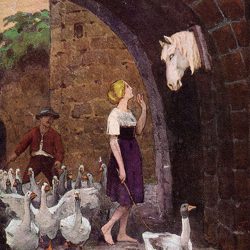Anne Anderson illustrated numerous fairy tales from the collection of Grimms. Well, sometimes editors were not so strict and added something else in the mixture as well.
To be honest, even the brothers Grimm didn’t bother, especially from the beginning, with an accuracy of their own content. But let’s not stray from the subject. In this post we’ll shortly present a book, published by The Childrens’ Press from Glasgow approximately in 1933.
This book was published in different versions, with a varying number of color and black and white illustrations. We’ll present what we have – six full color illustrations by Mrs Anderson – and hope to add some more in the future.
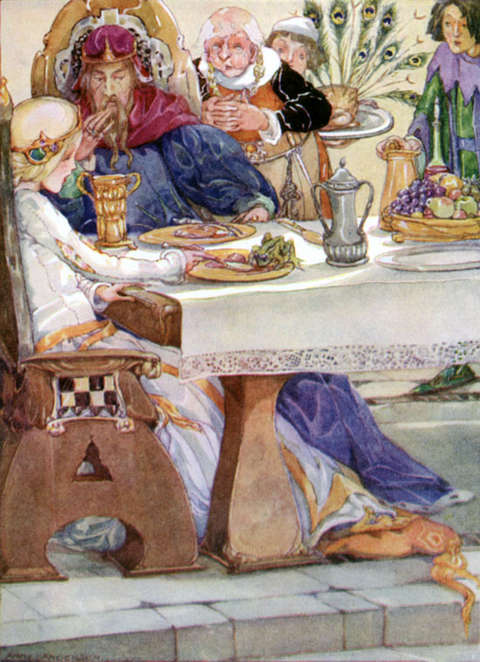
The Frog Prince
(She dined at the frog prince at her side)
We are probably all familiar with this iconic scene, where the little frog forced his way at the king’s table due his frivolous daughter’s promise. She didn’t like it, of course, yet they decided to get married only a few hours later.
The Frog Prince is a fairy tale about the importance of the given word. If you gave a promise, you should keep it. A rare quality in our times and definitely a chance to re-learn a thing or two from an old tale.
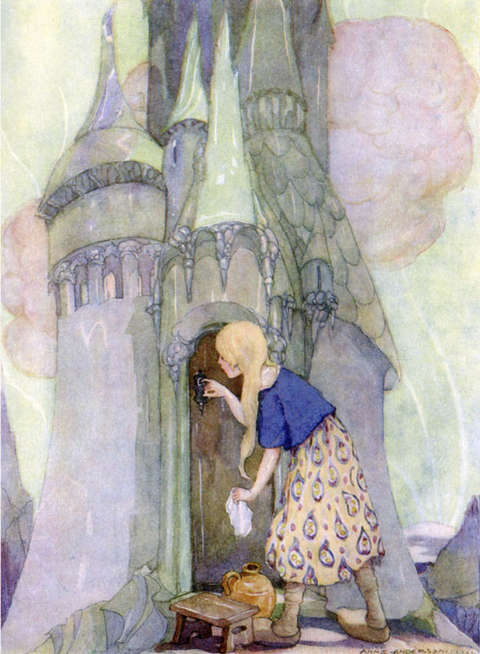
The Seven Crows
(The morning star gave her a bone to open the glass castle)
A little less known fairy tale from the collection with a classic plot – somebody (in this case it’s father) makes a mistake and others have to pay for it. All his seven sons are turned into crows and his only daughter has to travel the world to rescue them.
The scene above is a softened version of the original. When the girl needs a key to open the door, a morning star helps her with a bone in the right shape. Brothers Grimm wrote it a bit differently. In their draft of Seven Crows (Seven Ravens), the girl has to sacrifice her pinky to open the door.

The Snow White
(She was surrounded by seven dwarfs)
It’s one of the most popular fairy tales of all times and this scene was drawn by thousands of respectful artists from all over the world. There are numerous interpretations of the situation with a young girl living with seven adult men in the house, all suggesting the obvious – this fairy tale is all about growing up.
At the end of the story of Snow White, the girl finds the perfect man for her (actually he finds her, but who cares). Until then, she has to experiment with other men which are not good enough for her. This is why they are portrayed as little people and if somebody doubts this interpretation, just think how successful they were when a wicked witch tried to kill her!

Strong Hans
(The dwarf grinned at Hans like a sea-cat)
Strong Hans is another less known fairy tale by Brothers Grimm although it has everything a great story needs: a self made hero, a journey into the dangerous world, a dozen of robbers, a couple of false friends, a maiden in distress and, of course, some magic.
Maybe it has too much of everything? Anyway, the scene above portrays a crucial moment in Hans’ life. He finds a beautiful maiden in trouble and needs to defeat her guard. As this was not enough, he also has to find a way to get even with his treacherous companions. Of course, a happy ending follows.
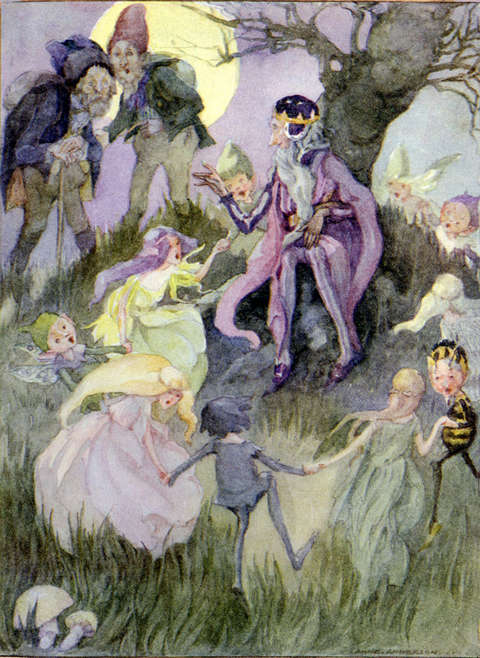
Presents of the Little Folk
(The moon had risen and the circle closed again)
Little folk is an expression for fairies, dwarfs, and other supernatural beings similar to us, but with some magic characteristics. Really interesting stories are made where our ‘real’ world and the fairy world collapse. This happens in Presents of the Little Folk (KHM 182) too.
Two friends travel together and accidentally bump into little folk partying in the wood. They are welcomed to join and got some presents (looking like coal) at farewell. But in the morning the coal turns into gold and one of the friends decides he wants more … A classic story about friendship, greed, and punishment.

Old Woman in the Woods
(Open the tree yoder, and inside you will find a bed)
Old Woman in the Wood (KHM 123) is another story about courage and an ordeal. It features a young girl who lost everything but her life just to find a handsome prince who (what else) is unfortunately enchanted by a wicked witch.
To restore order in her world, she has to face a dangerous enemy and show some trust in seemingly illogical assertions. We all learned from fairy tales this – trust – is sometimes the highest value of all. She got it and it pays off.

Rapunzel
(And the witch climbed up)
Rapunzel is one of the most popular stories ever, with classic elements shared from the love romances (literary predecessors of fairy tales): betrayal, obsession, forbidden love, revenge, … Rapunzel’s hair is a very powerful symbol which is in this case also used as a tool. First to get a glimpse of freedom and later as a punishment.
Rapunzel’s popularity rose up after Disney’s animated version with a completely different title: Tangled. The story is pretty changed as well, so, if you like the movie, don’t skip the fairy tale. The older versions by Jacob and William you find, the better.
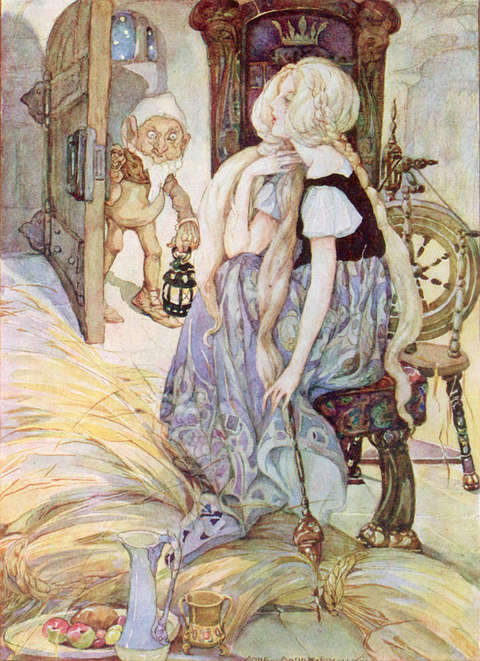
Miller’s Daughter
(He boasted she could spin straw into gold)
The Miller’s Daughter is not exactly Grimm’s fairy tale, but rather a Scottish version (Anne Anderson was Scottish) of German Rumpelstiltskin (KHM 55). The plot is pretty much the same. Miller is bragging and his daughter is put in danger. She got help but she has to pay for it. Fortunately, there’s a happy ending.
The scene is one of the two most popular scenes among illustrators of this tale. Anne Anderson used the other one in the book Old, old fairy tales.
Well, this is all for now. If we find more from this book (some black-and-white illustrations by Anne Anderson definitely exist), we’ll add them ASAP.

